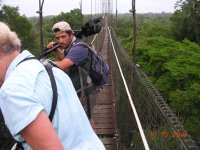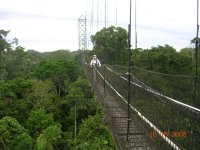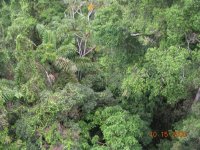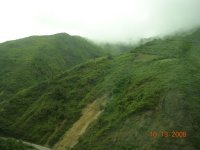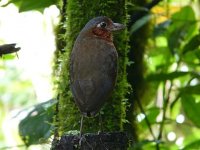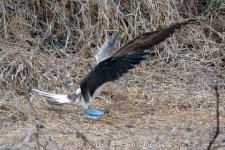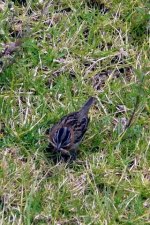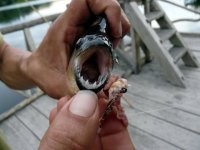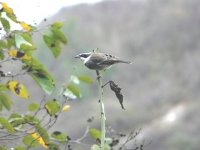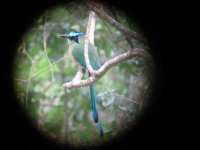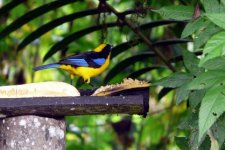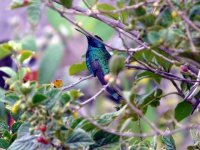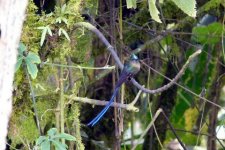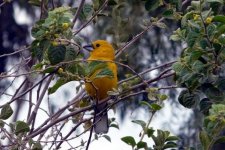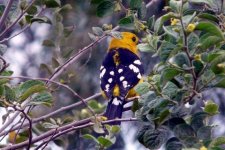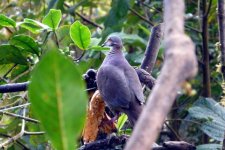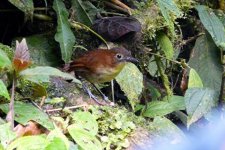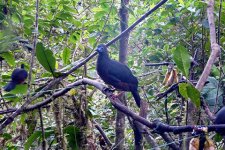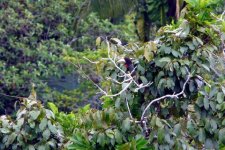Larry Lade
Moderator
I did have a great time in Ecuador. Although I did get a cough by the last couple of days there and have quite a cold now! Sniff, sniff. I do feel better today and think I will live!
I went swimming at the Sacha Lodge with a caiman and some pirañas as my companions! Roberto Cedeño, our guide, said they would not bother me and they didn't. It was a blast. Roberto is very enthusiastic and a competent birding guide. He made the trip very enjoyable and productive.
I thought that I would get around 300 - 350 "lifers". That estimate turned out to be a little high!
381 species were recorded for the trip (seen by at least someone in the group).
I recorded 349 species, I had seen 113 of these in the US and/or Costa Rica. That included things like Magnificent Frigatebirds, Black Skimmer, Great and Snowy Egrets, etc.
247 were new for me, eleven of these "new birds" were heard only.
So, 236 were actually "lifers" seen.
Here are a few of my highlights:
Red-billed Tropicbird, at Isla de la Plata (translates to Silver Island) this is off west coast.
Blue-footed Booby, at Isla de la Plata
Cocoi Heron, Rio Napo
Agami Heron, Sacha Lodge on Rio Napo
Slender-billed Kite
Double-toothed Kite
Ten species of parrots/parrotlet/parakeets, some particularly colorful ones, Cobalt-winged Parakeet, Scarlet-shouldered Parrotlet and an amazing Orange-cheeked Parrot (what a bird)!
Six species of owl, most noteable for me was a pair of Crested Owls.
Great Potoos and Common Potoo.
Twenty-one species of hummingbirds. (They have some 126 species in Ecuador!)
Golden-headed Quetzal
*The Toucan Barbet was repeatedly calling but would not come out of the vegetation to be seen, much to our dismay!
Crismson-rumped Toucanet
Ivory-billed Aracari
Pale-mandibled Aracari
Plate-billed Mountain-Toucan
A much admired Golden-collared Toucanet
Red-billed Toucan
And my favorite family of birds: Picidae
Ecuadorian Piculet
Yellow-tufted Woodpecker
Scarlet-backed Woodpecker
Red-rumped Woodpecker
Scaly-breasted Woodpecker
Cream-colored Woodpecker
Lineated Woodpecker
Crimson-crested Woodpecker
Guayaquil Woodpecker
* I also saw some Black-cheeked Woodpeckers, but it was not a new woodpecker for me as I had seen some of those in Costa Rica while on a birding trip there.
We saw quite a few "ant"birds
Our favorites being the antpittas, called out of the forest by Angel Paz. These are very elusive birds which Angel lures out into the open by feeding them earthworms every day.
Great Antpitta
Moustached Antpitta
and Yellow-breasted Antpitta
The Masked Water-Tyrants were neat.
There were lots of tanager, euphonia, dacnis, and the oropendolas put on quite a show.
We missed seeing the Andean Condor, but did see a couple of King Vultures although they were just specks in the sky. I would have liked to have gotten a closer look at them.
1. Here is a photo of our guide, Roberto, me and Stanley, another trip participant who resides in Guadalajara, Mexico. We are atop a 100 foot tall wooden tower which is build around a huge Kapok Tree.
2. Sky walk built between three 100+ foot tall steel towers.
3. Sky walk.
4. Looking down on rain forest from atop one of the steel towers.
5. A photo of the cloud (fog) forest as we are driving along in our bus.
I went swimming at the Sacha Lodge with a caiman and some pirañas as my companions! Roberto Cedeño, our guide, said they would not bother me and they didn't. It was a blast. Roberto is very enthusiastic and a competent birding guide. He made the trip very enjoyable and productive.
I thought that I would get around 300 - 350 "lifers". That estimate turned out to be a little high!
381 species were recorded for the trip (seen by at least someone in the group).
I recorded 349 species, I had seen 113 of these in the US and/or Costa Rica. That included things like Magnificent Frigatebirds, Black Skimmer, Great and Snowy Egrets, etc.
247 were new for me, eleven of these "new birds" were heard only.
So, 236 were actually "lifers" seen.
Here are a few of my highlights:
Red-billed Tropicbird, at Isla de la Plata (translates to Silver Island) this is off west coast.
Blue-footed Booby, at Isla de la Plata
Cocoi Heron, Rio Napo
Agami Heron, Sacha Lodge on Rio Napo
Slender-billed Kite
Double-toothed Kite
Ten species of parrots/parrotlet/parakeets, some particularly colorful ones, Cobalt-winged Parakeet, Scarlet-shouldered Parrotlet and an amazing Orange-cheeked Parrot (what a bird)!
Six species of owl, most noteable for me was a pair of Crested Owls.
Great Potoos and Common Potoo.
Twenty-one species of hummingbirds. (They have some 126 species in Ecuador!)
Golden-headed Quetzal
*The Toucan Barbet was repeatedly calling but would not come out of the vegetation to be seen, much to our dismay!
Crismson-rumped Toucanet
Ivory-billed Aracari
Pale-mandibled Aracari
Plate-billed Mountain-Toucan
A much admired Golden-collared Toucanet
Red-billed Toucan
And my favorite family of birds: Picidae
Ecuadorian Piculet
Yellow-tufted Woodpecker
Scarlet-backed Woodpecker
Red-rumped Woodpecker
Scaly-breasted Woodpecker
Cream-colored Woodpecker
Lineated Woodpecker
Crimson-crested Woodpecker
Guayaquil Woodpecker
* I also saw some Black-cheeked Woodpeckers, but it was not a new woodpecker for me as I had seen some of those in Costa Rica while on a birding trip there.
We saw quite a few "ant"birds
Our favorites being the antpittas, called out of the forest by Angel Paz. These are very elusive birds which Angel lures out into the open by feeding them earthworms every day.
Great Antpitta
Moustached Antpitta
and Yellow-breasted Antpitta
The Masked Water-Tyrants were neat.
There were lots of tanager, euphonia, dacnis, and the oropendolas put on quite a show.
We missed seeing the Andean Condor, but did see a couple of King Vultures although they were just specks in the sky. I would have liked to have gotten a closer look at them.
1. Here is a photo of our guide, Roberto, me and Stanley, another trip participant who resides in Guadalajara, Mexico. We are atop a 100 foot tall wooden tower which is build around a huge Kapok Tree.
2. Sky walk built between three 100+ foot tall steel towers.
3. Sky walk.
4. Looking down on rain forest from atop one of the steel towers.
5. A photo of the cloud (fog) forest as we are driving along in our bus.





